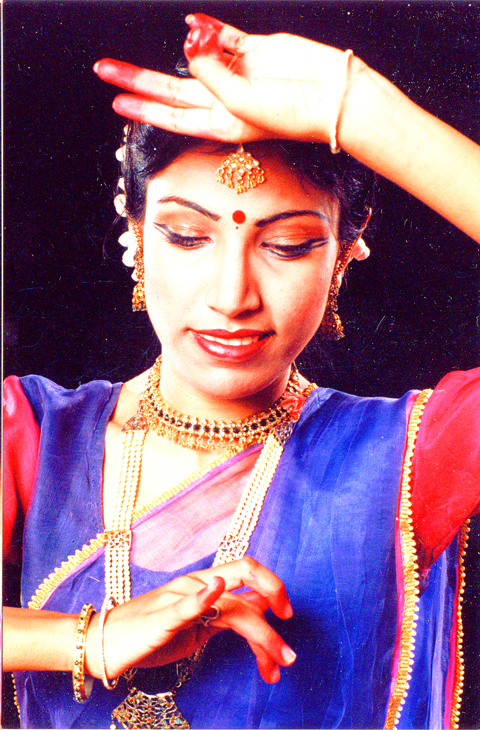With vividly painted faces, elaborate costumes and headdresses weighing as much as a small child, a troupe of Kathakali dancers from India are but one of the latest exotic acts to put on a show at the Dream Community (夢想社區).
The group is headlining this year’s Indian Cultural Festival, which starts tomorrow at the artist community in Shijr City (汐止) that is known for staging colorful parades and concerts.
On the schedule for the weeklong program: eight dance and dance drama performances by Indian and local troupes; seven workshops on classical Indian dance, yoga, South Asian cuisine, and the ancient healing art of Ayurvedic medicine; an exhibit of dancer’s costumes; and an outdoor Indian bazaar.

PHOTO: COURTESY OF TAIPEI INDIAN MUSIC AND CULTURE ORGANIZATION
The India Kaiamandaiam Kathakali Dance Group stages a form of Indian dance drama that originated during the late 16th century in what is now the southern Indian state of Kerala.
A highly developed art that combines literature, music, dance, theater and pantomime, Kathakali is one of the finest genres of Indian performance art. Intricate makeup and costumes, nuanced facial expressions and eye movements, and 24 mudras, or hand gestures, can, when combined in different ways, convey thousands of meanings, said troupe director Shiju Purushothaman.
“Mudras are like letters. Kathakali can talk to each other without talking,” said Purushothaman, who received six years of rigorous training at the
prestigious Kerala Kalamandalam performance art school.
Traditionally, Kathakali adapts stories from epics like Mahabharata and Ramayana. But to reach out to non-Indians, contemporary Kathakali artists adopt materials from other cultures. On April 26 at Taipei City Family Theater (台北市親子劇場), Purushothaman’s troupe will stage a Kathakali version of the Chinese classic Butterfly Lovers (梁山伯與祝英台) that took the veteran artist two years to complete.
“In Kathakali, we talk in poetry. I have to first transform the Chinese story into poems and sync it with our music,” Purushothaman explained.
Indian dancers usually spend decades learning art forms like these, which demand immense concentration. Sangita Chaherjee, who will perform solos during the festival, has studied the classical dance of Northern India since childhood.
Popularized by Bollywood, her dance form is characterized by graceful movements, subtle facial expressions — unlike the more dramatic expressions in Kathakali — and fast footwork.
The young artist is happy to add contemporary materials to her 2,000-year-old art form.
“Once you finish the training [and are] deeply rooted in the tradition, you are free to create your own thing,” Chaherjee said. “Younger generations of artists like myself tend to explore new possibilities … . We aim for an international outlook and try to bring India to the globe.”

Behind a car repair business on a nondescript Thai street are the cherished pets of a rising TikTok animal influencer: two lions and a 200-kilogram lion-tiger hybrid called “Big George.” Lion ownership is legal in Thailand, and Tharnuwarht Plengkemratch is an enthusiastic advocate, posting updates on his feline companions to nearly three million followers. “They’re playful and affectionate, just like dogs or cats,” he said from inside their cage complex at his home in the northern city of Chiang Mai. Thailand’s captive lion population has exploded in recent years, with nearly 500 registered in zoos, breeding farms, petting cafes and homes. Experts warn the

The unexpected collapse of the recall campaigns is being viewed through many lenses, most of them skewed and self-absorbed. The international media unsurprisingly focuses on what they perceive as the message that Taiwanese voters were sending in the failure of the mass recall, especially to China, the US and to friendly Western nations. This made some sense prior to early last month. One of the main arguments used by recall campaigners for recalling Chinese Nationalist Party (KMT) lawmakers was that they were too pro-China, and by extension not to be trusted with defending the nation. Also by extension, that argument could be

Aug. 4 to Aug. 10 When Coca-Cola finally pushed its way into Taiwan’s market in 1968, it allegedly vowed to wipe out its major domestic rival Hey Song within five years. But Hey Song, which began as a manual operation in a family cow shed in 1925, had proven its resilience, surviving numerous setbacks — including the loss of autonomy and nearly all its assets due to the Japanese colonial government’s wartime economic policy. By the 1960s, Hey Song had risen to the top of Taiwan’s beverage industry. This success was driven not only by president Chang Wen-chi’s

The centuries-old fiery Chinese spirit baijiu (白酒), long associated with business dinners, is being reshaped to appeal to younger generations as its makers adapt to changing times. Mostly distilled from sorghum, the clear but pungent liquor contains as much as 60 percent alcohol. It’s the usual choice for toasts of gan bei (乾杯), the Chinese expression for bottoms up, and raucous drinking games. “If you like to drink spirits and you’ve never had baijiu, it’s kind of like eating noodles but you’ve never had spaghetti,” said Jim Boyce, a Canadian writer and wine expert who founded World Baijiu Day a decade